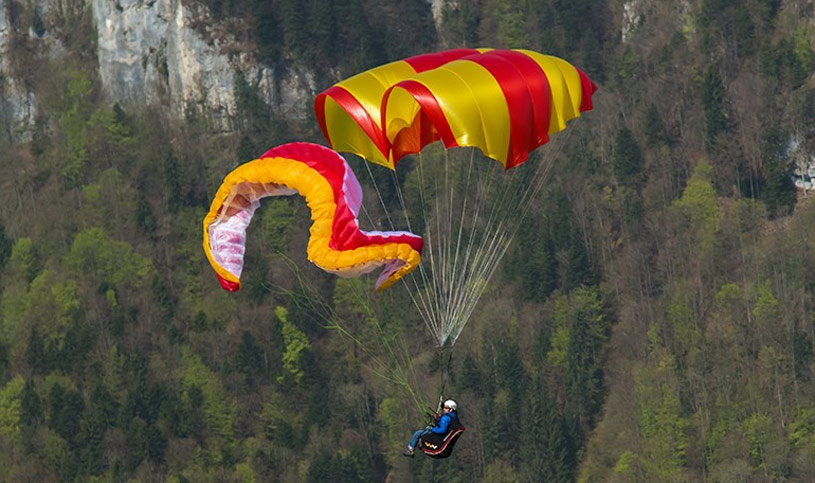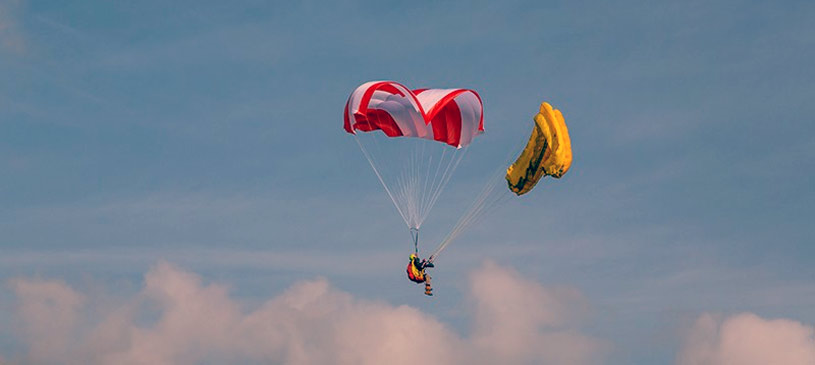
In 1995 High Adventure opened a new chapter in the history of paraglider reserve parachutes with the Beamer, a paragliding reserve based on the famous Rogallo wing concept. In this enlightening interview with Urs Haari, we talk about the development process, modern reserves, the lightweight fashion, small sizes, tracking (airspeed) and the reserve parachutes of the future.
THE DEVELOPMENT OF THE BEAMER
The original High Adventure Beamer was designed for use with quick-out carabiners in mind. It was not designed for leaving the paraglider attached. In the event the paraglider got into an irrecoverable configuration, the pilot would first deploy the Beamer then release the paraglider with the quickouts (coupled with a speed system release system), leaving them flying a steerable Rogallo reserve.
The most obvious important advantage of the Rogallo concept over conventional round PDA reserves, and other non-steerable designs, is that it offers the possibility of being able to choose where you land and what you land on. Have you ever looked down at power-lines, rocks, buildings, vine plantations … and wondered: "What if I had to throw my reserve now?"
The Rogallo design also has other important advantages over conventional round PDA reserves: faster opening and lower descent rate. Since you can steer, it also offers the possibility of turning it into wind thereby reducing your landing speed (ground speed).
So the Beamer 1 was a great new solution for pilots, but it had limitations. If the paraglider was left attached then there was a possibility of downplaning. This was not good if the pilot did not have time, or was unable, to operate the quickouts (for example, in the case of a low level deployment). We only experienced this problem with high wing loading and passive behavior of the pilot. Otherwise, the Beamer 1 worked reliably. Even heavily-loaded pilots managed a safe descent, even when still attached to the main wing, if using the right technique. (See a couple of short videos showing some Beamer 1 openings and landings).

The added complication of needing to operate quickouts in a potentially high-stress situation, might also be too much for some pilots. [Flybubble: Some pilots chose to fly with two reserves to allow for all situations e.g. in case of downplaning, or the first reserve fails for any reason: the Beamer 1, to be used if enough height to operate the quickouts and release the paraglider, plus a non-steerable reserve for low level deployments or in case the pilot was unable to operate the quickouts for any reason.]
It's from this stage in the development of paragliding Rogallo reserves that some pilots have formed their opinions about them. Indeed some Rogallo style reserve systems haven't progressed past this stage. (Some of the Rogallos available on the market even today are too small and work poorly when the pilot remains connected to the main wing. I think the bad image some still have of all Rogallos is based on these inferior systems, however in reality it is not right to judge all Rogallos the same. There are good and bad Rogallos, the same as for other types of reserve and other equipment.)
High Adventure decided to develop the concept further, and see if they could find solutions to the limitations of the existing systems by developing a Rogallo reserve system that worked with the paraglider attached.
To do this, extensive development and testing was needed, which required a big investment of resources: people, time, money. As well as lots of testing over water and detaching the paraglider (as per certification tests), High Adventure did extensive testing over ground with the paraglider attached (which most other reserve manufacturers don’t do). Reserve testing over the ground is generally done with 'dummy' weights; pilot testing and certification flights are done over water.

Urs’ findings were that for all reserve types, 'big is beautiful'. The more airspeed a reserve has, the more the chance of mirror effect or downplaning is increased. Smaller reserves result in higher loading, higher descent rate and higher airspeed.
The Beamer 1 had an area of 38m2 and weighed 2.9kg. Suddenly, new materials became available and we were able to increase the surface area (to 41.75 m2) whilst at the same time drastically reducing the weight and volume.
Urs also developed a pre-braking opening system for the Beamer. The main benefit is that (in combination with a larger area) it significantly reduces the tendency for downplaning; it also reduces the airspeed, which reduces ground speed in the event of a downwind landing.
After years of intensive research and development, testing, perfecting the design, improving production methods and materials and learning from the real-life experiences of pilots, High Adventure were happy that they had developed a new Rogallo-type reserve system which did not require the use of quickouts, and worked at high or low level with or without the paraglider still attached.

In 2010 High Adventure released the Beamer 2 whose new features and improved qualities set another benchmark for steerable paraglider reserves. The Beamer 2 was also significantly lighter and more compact (lower packing volume) than the original.
After some initial scepticism, due to expectations caused by the limitations of the original Beamer and other Rogallo-style reserves from other manufacturers, the Beamer 2 soon proved itself 'in the field' and gradually convincingly established itself in the paragliding market.
"Every great idea goes through three phases. At first it's laughed at; then it's violently opposed – finally it becomes accepted as obvious." Arthur Schopenhauer
Urs further refined the Beamer 2’s riser system, improving installation, operation and opening, and slightly reducing weight and packing volume, and released these improvements as the new Beamer 3 in 2013. The canopy itself was unchanged. (Theoretically it's possible to upgrade a B2 to a B3, by replacing the riser system and some lines, however in reality this might prove uneconomical to do.)
Due to popular demand, High Adventure also released a smaller size Beamer 3, and light versions of both sizes.

MODERN RESERVES
In the realm of freeflight reserve parachutes, lightweight has become very fashionable. Those who advertise lightest (and, to a lesser degree, most compact) win sales. However, Urs Haari thinks this trend is not necessarily good for pilot safety because this encourages
- smaller size reserves and
- the use of lighter materials.
SMALL SIZE
Urs feels that the current (and to a greater extent, past) test systems, EN and LTF, allow reserves that are too small to get through tests.
Pilots beware!
- Reserve tests are only done with steady winds i.e. smooth air.
- Reserve descent rates are calculated to standard atmosphere.
- And, most importantly, the main wing is released
They do not test with the main wing attached because it's impossible to get the same result each time, making a scientifically repeatable result impossible. However, the way you will use your reserve will be: in turbulent air, at the height of summer in the mountains, with your paraglider attached.
A paraglider pilot called Alois Rettenbacher has done extensive reserve testing with and without main wing attached. His findings for all reserve types: if the canopy loading is too high (smaller reserve) and the main wing still flying, then there is a high risk of mirror effect. Alois has often measured descent rates higher than the allowed maximum for EN tests, which is 5.5m/s. He has measured descent rates of 7.5 m/s on reserves that passed EN tests on more than one occasion!
Most experienced reserve testers agree: don't be high up the EN certified weight range, whatever type of reserve you choose!
This is why the Beamer 3 is so large. High Adventure weren't keen to make a smaller version, but pilots demanded a lighter, more compact reserve so the Beamer 3 S was developed. Although certified to 100 kg, Urs recommends a maximum of 90 kg all up.

LIGHTWEIGHT MATERIALS
The trend for lightweight materials creates a safety issue because they are not as durable and the fabric can be easily damaged. In the case of a tree landing, the reserve is often written off because it is uneconomical to repair. Sometimes even after water landings, if the pilot and rescuer are not careful, the canopy can get damaged. Urs has heard of lightweight reserves being badly damaged from wooden piers, sharp edges, water-logged reserves being dragged across rough surface.
TIP: Put your deployed reserve into a heavy-duty plastic bag (like a rubble sack, or those used for gardening) to protect it.
All the top reserve manufacturers work with the same best materials, so all have similar problems in this regard (or worse, if using inferior materials). Urs feels that too many pilots are buying into this lightweight equipment trend and getting kit not well suited to them, because the fashion is hike&fly but pilots don't realise what they are compromising!
TRACKING (AIRSPEED)
Round, square and square-round design parachutes don’t descend vertically through the air; during tests carried out in a joint venture with Nova, High Adventure found they all track across the ground at between 12-14 km/hr.
Urs added “Tracking is not a problem in itself, it’s better to hit the ground more horizontally and less vertically. There’s less chance of injury, as we have seen in real-life reserve deployments.”
Forward speed (airspeed) is only a problem when the reserve is too small, and connected to a wing. If it happens to glide in the opposite direction to the main wing, it will be more likely to go into a downplane with a high descent rate.
STEERING
A tracking reserve is not so much of a problem if this happens to be taking you towards a favourable landing spot. However, since most designs are not capable of being steered, this means that, as well as having a relatively high descent rate of 5+ m/s, coming down under a traditional non-steerable reserve gives the pilot no possibility to steer away from nasty hazards if your drift happens to be taking you that way.
The discussion and choice of reserve is not simple one, even with money no object it is still a matter of personal preference, but this factor makes a big argument in favour of the steerable reserve.
THE FUTURE
Urs feels that the reserve testing system needs to be improved because it is not close enough to the real life situation during a reserve deployment. Along with others, he has been doing lots of testing with the main wing attached. In this configuration, many reserves display higher sink rates than during certification. The recent trend for acro has been good for reserve development in that there are now a lot more reserve deployments than there were before.
Many acro pilots choose the Beamer 2 or 3 as their main reserve, and a round PDA as their backup. Some pilots throw the Beamer and, if this gets caught with the lines or the sail, then throw the round as well. Watching this Beamer plus round combo-deploy has given Urs the idea that an interesting possibility for testing could be to use the extra round reserve to provide a standard resistance to the reserve being tested, to closer match the usage in real life.
See our range of reserve parachutes
Want to see more? There’s no better way to support our efforts than buying from us. We’ll ensure you get great service! Choose from our great range AND enable us to produce more videos and articles to benefit the freeflight community.

